| Constitutional Convention Reading with Questions |
|---|
| www.studenthandouts.com ↣ American History ↣ American History Readings with Questions |
By the time the Northwest Ordinance was enacted, American leaders were in the midst of drafting a new and stronger constitution to replace the Articles of Confederation. Their presiding officer, George Washington, had written accurately that the states were united only by a "rope of sand." Disputes between Maryland and Virginia over navigation on the Potomac River led to a conference of representatives of five states at Annapolis, Maryland, in 1786. One of the delegates, Alexander Hamilton of New York, convinced his colleagues that commerce was bound up with large political and economic questions. What was required was a fundamental rethinking of the Confederation.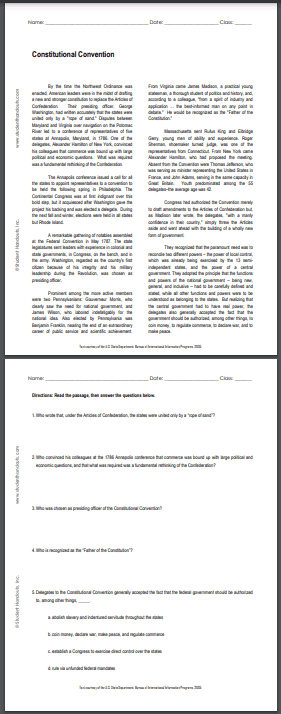 The Annapolis conference issued a call for all the states to appoint representatives to a convention to be held the following spring in Philadelphia. The Continental Congress was at first indignant over this bold step, but it acquiesced after Washington gave the project his backing and was elected a delegate. During the next fall and winter, elections were held in all states but Rhode Island.
The Annapolis conference issued a call for all the states to appoint representatives to a convention to be held the following spring in Philadelphia. The Continental Congress was at first indignant over this bold step, but it acquiesced after Washington gave the project his backing and was elected a delegate. During the next fall and winter, elections were held in all states but Rhode Island.A remarkable gathering of notables assembled at the Federal Convention in May 1787. The state legislatures sent leaders with experience in colonial and state governments, in Congress, on the bench, and in the army. Washington, regarded as the country's first citizen because of his integrity and his military leadership during the Revolution, was chosen as presiding officer. Prominent among the more active members were two Pennsylvanians: Gouverneur Morris, who clearly saw the need for national government, and James Wilson, who labored indefatigably for the national idea. Also elected by Pennsylvania was Benjamin Franklin, nearing the end of an extraordinary career of public service and scientific achievement. From Virginia came James Madison, a practical young statesman, a thorough student of politics and history, and, according to a colleague, "from a spirit of industry and application ... the best-informed man on any point in debate." He would be recognized as the "Father of the Constitution." Massachusetts sent Rufus King and Elbridge Gerry, young men of ability and experience. Roger Sherman, shoemaker turned judge, was one of the representatives from Connecticut. From New York came Alexander Hamilton, who had proposed the meeting. Absent from the Convention were Thomas Jefferson, who was serving as minister representing the United States in France, and John Adams, serving in the same capacity in Great Britain. Youth predominated among the 55 delegates–the average age was 42. Congress had authorized the Convention merely to draft amendments to the Articles of Confederation but, as Madison later wrote, the delegates, "with a manly confidence in their country," simply threw the Articles aside and went ahead with the building of a wholly new form of government. They recognized that the paramount need was to reconcile two different powers – the power of local control, which was already being exercised by the 13 semi-independent states, and the power of a central government. They adopted the principle that the functions and powers of the national government—being new, general, and inclusive—had to be carefully defined and stated, while all other functions and powers were to be understood as belonging to the states. But realizing that the central government had to have real power, the delegates also generally accepted the fact that the government should be authorized, among other things, to coin money, to regulate commerce, to declare war, and to make peace. Directions: Read the text above, then answer the questions below. 1. Who wrote that, under the Articles of Confederation, the states were united only by a "rope of sand"? 2. Who convinced his colleagues at the 1786 Annapolis conference that commerce was bound up with large political and economic questions, and that what was required was a fundamental. 3. Who was chosen as presiding officer of the Constitutional Convention? 4. Who is recognized as the "Father of the Constitution"? 5. Delegates to the Constitutional Convention generally accepted the fact that the federal government should be authorized to, among other things, _____. (a) abolish slavery and indentured servitude throughout the states (b) coin money, declare war, make peace, and regulate commerce (c) establish a Congress to exercise direct control over the states (d) rule via unfunded federal mandates Click here to print. |
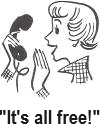 | 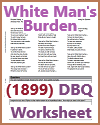 | 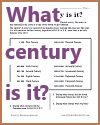 | 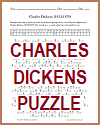 | 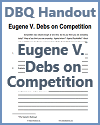 |
| www.studenthandouts.com ↣ American History ↣ American History Readings with Questions |








